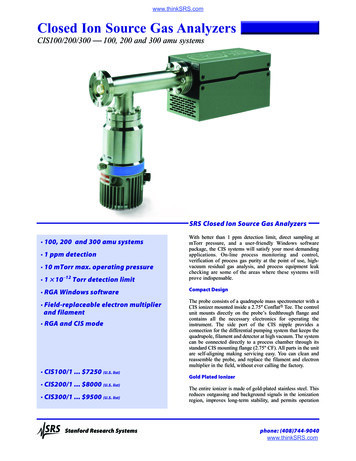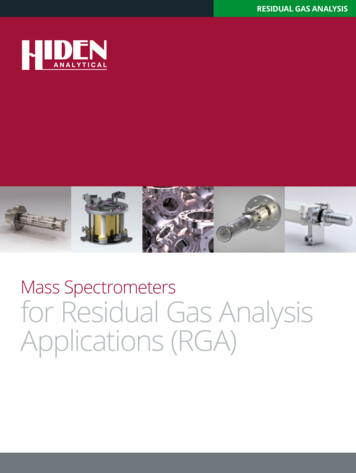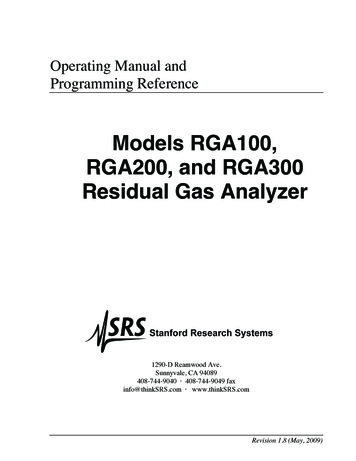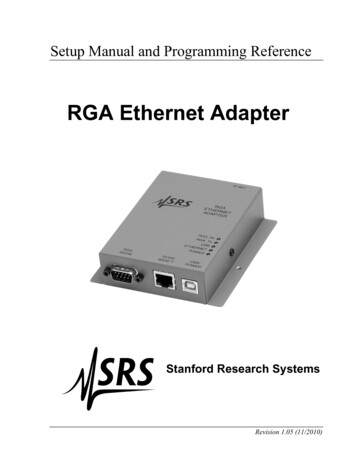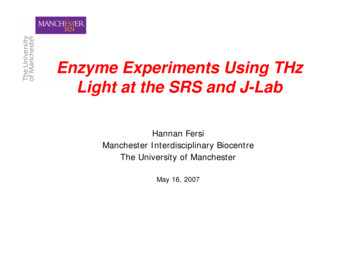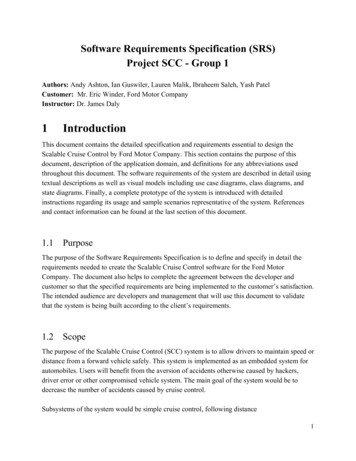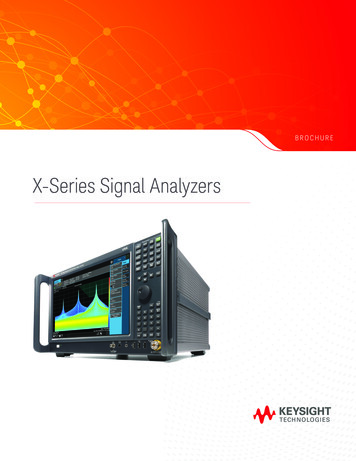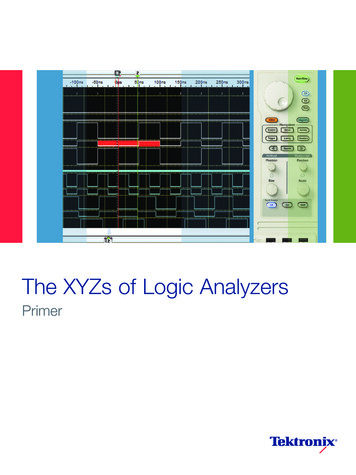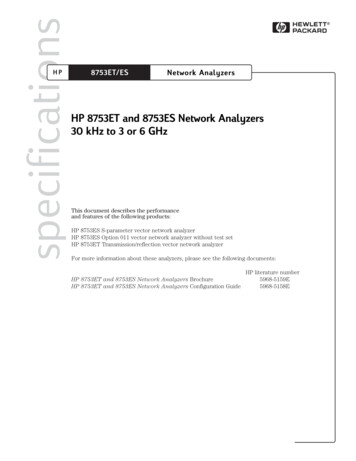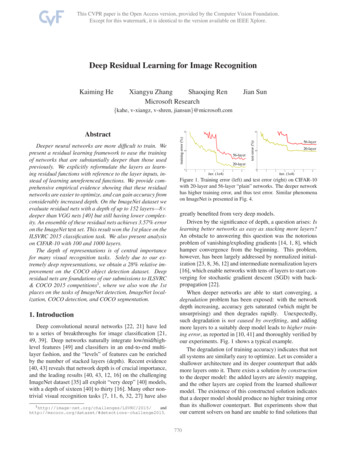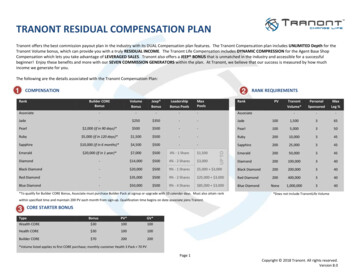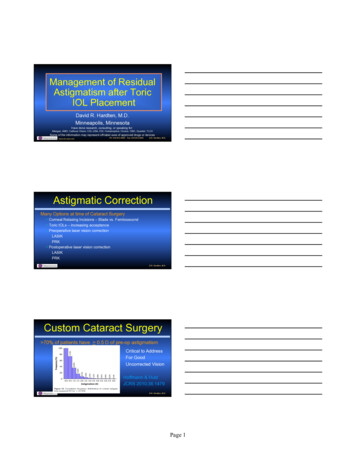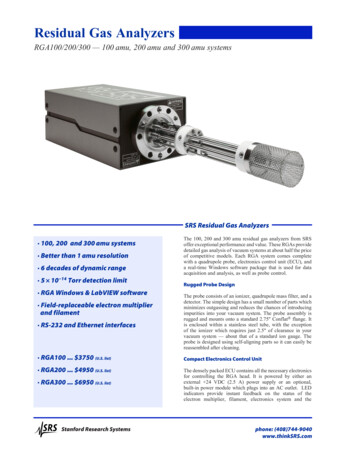
Transcription
Residual Gas AnalyzersRGA100/200/300 — 100 amu, 200 amu and 300 amu systemsSRS Residual Gas Analyzers· 100, 200 and 300 amu systems· Better than 1 amu resolution· 6 decades of dynamic range· 5 10 14 Torr detection limit· RGA Windows & LabVIEW software· Field-replaceable electron multiplierand filament· RS-232 and Ethernet interfaces· RGA100 . 3750 (U.S. list)· RGA200 . 4950 (U.S. list)· RGA300 . 6950 (U.S. list)The 100, 200 and 300 amu residual gas analyzers from SRSoffer exceptional performance and value. These RGAs providedetailed gas analysis of vacuum systems at about half the priceof competitive models. Each RGA system comes completewith a quadrupole probe, electronics control unit (ECU), anda real-time Windows software package that is used for dataacquisition and analysis, as well as probe control.Rugged Probe DesignThe probe consists of an ionizer, quadrupole mass filter, and adetector. The simple design has a small number of parts whichminimizes outgassing and reduces the chances of introducingimpurities into your vacuum system. The probe assembly isrugged and mounts onto a standard 2.75" Conflat flange. Itis enclosed within a stainless steel tube, with the exceptionof the i onizer which requires just 2.5" of clearance in yourvacuum system — about that of a standard ion gauge. Theprobe is designed using self-aligning parts so it can easily bereassembled after cleaning.Compact Electronics Control UnitThe densely packed ECU contains all the necessary electronicsfor controlling the RGA head. It is powered by either anexternal 24 VDC (2.5 A) power supply or an optional,built-in power module which plugs into an AC outlet. LEDindicators provide instant feedback on the status of theelectron multiplier, filament, electronics system and theStanford Research Systems phone: (408)744-9040www.thinkSRS.com
RGA100/200/300 Residual Gas Analyzersprobe. The ECU can easily be removed from the probe forhigh- temperature bakeouts.Unique Filament DesignA long-life, dual thoriated-iridium (ThO2/Ir) filament is usedfor electron emission. Dual ThO2/Ir filaments last muchlonger than single filaments, maximizing the time betweenchannel, continuous-dynode electron multiplier (EM) offersincreased longevity and stability, and can also be replaced bythe user — a first for RGAs.Useful FeaturesSRS RGAs have a built-in degassing feature. Using electronimpact desorption, the ion source is thoroughly cleaned, greatlyreducing the ionizer’s contribution to background noise.A firmware driven filament protection feature constantlymonitors (675 Hz) for over pressure. If over pressure is detected,the filament is immediately shut off, preserving its life.A unique temperature-compensated, logarithmic electrometerdetects ion current from 10–7 to 10–15 amps in a single scan,with better than 2 % precision. This huge dynamic rangemeans you can make measurements of small and large gasconcentrations simultaneously.Complete ProgrammabilityDual ThO2/Ir filamentfilament replacement. Unlike other designs, SRS filamentscan be replaced by the user in a matter of minutes.Continuous Dynode Electron MultiplierCommunication with computers is made via the RS-232interface. Analog and histogram (bar) scans, leak detection,and probe parameters are all controlled and monitored througha high-level command set. This allows easy integration intoexisting programs.RGA Windows SoftwareThe RGA systems are supported with a real-time Windowssoftware package that runs on PCs. The intuitive graphicaluser interface allows measurements to be made quicklyA Faraday cup detector is standard with all SRS RGAs,allowing partial pressure measurements from 10–5 Torr to5 10–11 Torr. For increased sensitivity and faster scan rates,RGA Windows software — Analog modeContinuous dynode electron multiplieran optional electron multiplier is offered that detects partialpressures down to 5 10–14 Torr. This state-of-the-art, multi-Stanford Research Systemsand easily. The program is fully interactive, giving the user complete control of the graphical display. Screens can besplit for dual-mode operation, scales can be set to l inear orlog format, and data can be scaled manually or automatically.Data is captured and displayed in real time or scheduled foracquisition at a given time interval for long-term data logging.Features include user-selectable units (Torr, mbar, Pa and A), programmable audio and visual alarms, and comprehensiveon-line help.phone: (408)744-9040www.thinkSRS.com
RGA100/200/300 Residual Gas AnalyzersThe software also allows complete RGA head control witheasy mass scale tuning, sensitivity calibration, ionizer setup,and electron-multiplier gain adjustment. For further analysis,data files can be saved in ASCII format for easy transfer intospreadsheets. Graphic images can be saved as META filesor copied to the clipboard for importing directly into otherWindows programs. The software also provides passwordprotection for locking out head p arameters so that casual users can’t alter important settings. A LabVIEW driver is alsoavailable on the SRS website.An optional stand-alone monitor (PPM100) can be used tocontrol the RGA without a host computer.RGA rear panel(without AC power module)Multi-Head OperationThe software supports multiple head operation when morethan one RGA is needed. Up to eight ECUs can be monitoredfrom the software.Performance and ValueThe SRS family of RGAs is ideal for applications involving gasanalysis, leak detection, and vacuum processing. We offer 100,200 and 300 amu systems with supporting Windows software,and options that include an electron multiplier and a built-inpower module for AC line operation. The RGA Windowssoftware is available on the web at www.thinkSRS.com.RGA rear panel(with AC power module)RGA dimensional drawing (inches)Stanford Research Systems phone: (408)744-9040www.thinkSRS.com
RGA100/200/300 SoftwareAnalog mode provides a line graphrepresentation of the acquired massspectrum (partial pressure vs. massnumber). Span, resolution and noise floorcan each be set. Scans can be single-shot,timed or taken continuously.Pressure vs. time presents a strip chart ofpartial pressures for selected masses, andprovides a complete time history of yourdata. Complete scrolling and zoom controlis available even while data is beingacquired. This mode is most often used formonitoring process trends.Library mode contains a comprehensivelist of gases that can be used to compareagainst the current spectrum. A searchmode allows you to select up to 12 massesand identify and display (numerically andgraphically) the intensity of all gases thatcontain these masses.Histogram mode displays a bar graph ofpartial pressure vs. mass, allowing thespectrum to easily be interpreted. Thismode is often used for quick and easyvacuum analysis. The screen can be splitfor viewing two modes of operationsimultaneously.Leak detection mode monitors a particularmass number (not just helium) over time,and combines many features of the previousmodes. A vertical bar graph provides avisual reference for viewing changes inintensity from a distance. A programmableaudible tone, large numeric read-out, andvisual alarm are also provided.Analysis utility provides an approximationof the composition of gases beingmonitored by the RGA. Since more thanone gas can contribute to a particularamu’s partial pressure, the analysis mode isextremely useful in determining the makeup of complex gases. Up to 12 commongases can be selected for the analysis.Table mode provides a readout of mass,scaling factor, and true partial pressure.The display shows the peak heights andalarm status of up to 10 masses. Theelectron multiplier can be independentlyset on or off for each mass. This allowsthe user to view minor species even in thepresence of high total pressure.Annunciator mode is provided forconveniently monitoring up to 10 masses.If a particular mass has tripped its presetalarm, the large box will turn red indicatinga problem. An audible alarm will also bepresent until the mass falls back within itspreset limits. This mode is most often usedfor Go/No-Go testing.Multi-head operation is available whenmore than one RGA is needed for analysis.Up to eight heads can be monitoredsimultaneously from the software.Stanford Research Systemsphone: (408)744-9040www.thinkSRS.com
RGA100/200/300 SpecificationsOperationalMass rangeRGA100RGA200RGA300Mass filter typeDetector typeResolution(per AVS std. 2.3)Sensitivity (A/Torr)Minimum detectablepartial pressureOperating rangeOperating temperatureBakeout temperatureGeneral1 to 100 amu1 to 200 amu1 to 300 amuQuadrupoleFaraday cup (FC), standardElectron multiplier (EM), optionalBetter than 0.5 amu @ 10 % peakheight. Adjustable to constant peakwidth throughout the mass range.2 10–4 (FC), 200 (EM). Useradjustable throughout high voltagerange. Measured with N2 @ 28 amuwith 1 amu full peak width,10 % height, 70 eV electron energy,12 eV ion energy, and 1 mA electronemission current.5 10–11 Torr (FC),5 10–14 Torr (EM)Measured with N2 @ 28 amu with1 amu full peak width, 10 % height,70 eV electron energy, 12 eV ionenergy, and 1 mA electronemission current.10–4 Torr to UHV (FC)10–6 Torr to UHV (EM)70 C (max.)300 C (without ECU)IonizerDesignMaterialFilamentElectron energyIon energyFocus voltageElectron emission currentOpen ion source, cylindricalsymmetry, electron impact ionizationSS304 constructionThoriated iridium (dual) withfirmware protection. Built-in1 to 10 W degas ramp-up.(Field replaceable)25 to 105 V, programmable8 or 12 V, programmable0 to 150 V, programmable0 to 3.5 mA, programmableProbe dimensionProbe insertionProbe mounting flangeMinimum tube I.D.ECU dimensionsLED indicatorsWarm-up timeComputer interfaceSoftwarePower requirementWeightWarranty8.75" from flange face to topof ionizer2.0"2.75" CF1.375"3.1" 4.1" 9.1" (WHD). Easilyseparated from the probe for bakeout.Power ON/OFF, filament ON/OFF,degas ON/OFF, electron multiplierON/OFF, RS-232 Busy, Error,Overpressure, Burnt FilamentMass stability 0.1 amu after 30 min.RS-232C, 28,800 baud with high-level command setWindows based application24 VDC @ 2.5 amps, male DB9connector, optional built-in powermodule for AC line operation6 lbs.One year parts and labor on defectsin materials and workmanshipOrdering InformationRGA100RGA200RGA300Option 01Option 02Option 0 amu RGA w/ RS-232200 amu RGA w/ RS-232300 amu RGA w/ RS-232Electron multiplierAC power moduleIon counting outputHeater jacketMax. insertion nipple (4.5" CF)Ethernet adapter for RGAReplacement electron multiplierReplacement ThO2/Ir filamentReplacement ionizer kit(includes filament)Optional stand-alone monitor 3750 4950 6950 1500 250 250 995 695 495 1100 250 500 2995Maximum insertion nipple (O100MAX)Stanford Research Systems phone: (408)744-9040www.thinkSRS.com
The software supports multiple head operation when more than one RGA is needed. Up to eight ECUs can be monitored from the software. Performance and Value The SRS family of RGAs is ideal for applications involving gas analysis, leak detection, and vacuum processing. We offer 100, 200 and 300 amu systems with supporting Windows software,File Size: 1MBPage Count: 5
